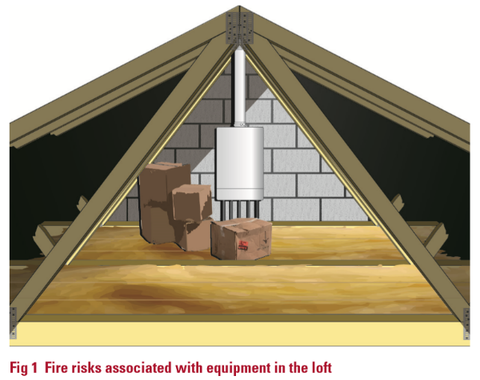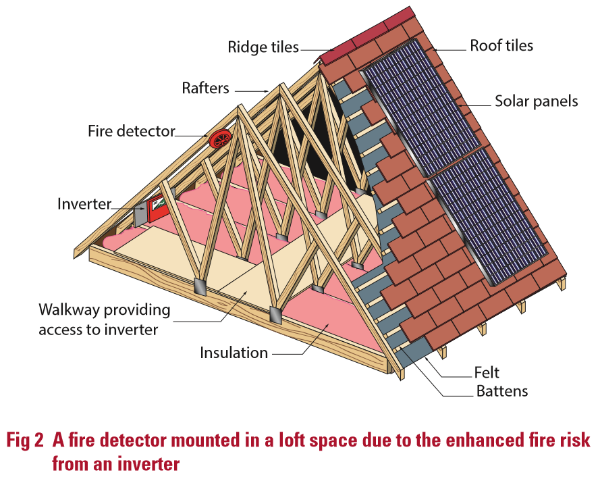NICEIC has produced this guide covering the risks that need to be considered when mounting electrical equipment in loft spaces in domestic premises.

The installation of electrical equipment in loft spaces of domestic premises is becoming more common, so this article discusses the risks that need to be considered when mounting equipment in such spaces including: central heating boilers, inverters for solar photovoltaic systems, water pumps and similar types of equipment that typically require infrequent handling or visual monitoring.
Electrical equipment mounted in any location can, in the event of a fault or incorrect installation, become a source of ignition. A loft, by its nature, may provide a ready source of fuel enabling a fire to become rapidly established. This is typically because a loft:
- is comprised of exposed timbers,
- may have a roof covering with a degree of flammability, such as thatch or felt,
- is used to stored items which may be combustible, or be stored in combustible containers, such as cardboard boxes.
It should be noted that a loft can be subjected to a wide range of temperatures, for example, below freezing in the winter months and, say, 35 ºC in the summer months.
Therefore, to ensure operation of the equipment does not present a fire risk, as for any installed equipment, the manufacturer’s instructions should be taken into account (Regulation 134.1.1 of BS 7671 refers).
Risks to persons associated with equipment in the loft
Where electrical equipment is mounted in the loft, it must be accessible to, for example, carry out maintenance and repair (Regulation 132.12 of BS 7671 refers).
To avoid hazards to skilled persons entering the loft when carrying out work, such as replacing an item of equipment, there must be safe access, a working platform (for example, floorboards) and adequate lighting (Regulation 15 of the Electricity at Work Regulations 1989 refers).
Furthermore, without a safe permanent means of access and lighting to the equipment, occupants may be put at risk when, for example, they decide to investigate why a particular piece of equipment in the loft which provides function for the living space has malfunctioned.
The guidance given in BS 5839-6
Clause 11 (Location and siting of fire detectors) comments that, in cases where certain electrical equipment is mounted in the loft, a Category LD2 system might incorporate a smoke detector within the loft space.
Clause A.6 of Annex A (Consideration of ignition sources) acknowledges that electrical appliances and wiring are the second most common source of ignition of accidental fires in dwellings. The clause also recognises that electrical equipment mounted in lofts contribute to the fire statistics and, where the loft is selected for mounting such equipment, there might be justification for a fire detector*.
Fire detectors in single-family domestic premises are generally mounted in kitchens, hallways, landings and lounges to form a Grade D Category LD2 fire detection and fire alarm system for protection of life. However, the fire risk assessment may identify additional risk factors which may warrant, for example, a fire detector in the loft (clause 4.2 refers).
Should a fire detector be selected for the loft, it must, amongst other things, be accessible for maintenance and have accessible means of being silenced in the event of a false alarm (clauses 11.2(n) and 12.2(a) refer respectively).

Fire risk assessment
To assess whether fire detectors are required in any particular location of a dwelling, including a loft space, a fire risk assessment should take into account (amongst other things):
- the probability of fire occurring in the location
- the probability of early detection and warning to occupants before significant fire spread occurs.
With the increase in the use of electrical equipment in the loft space and the likelihood of no one becoming aware that a fire exists until it is established, it is likely that any fire risk assessment will highlight the need for mounting an automatic fire detector in the loft space.
More importantly, providing a fire detector in the loft as part of a fire detection and fire alarm system may provide an early warning signal and vital time for occupants to safely evacuate the premises and summon the Fire and Rescue Service before they are endangered and the property suffers major damage.
Summary
Where a contractor plans to install electrical equipment in the loft of domestic premises, consideration should be given to the type of equipment and its operational characteristics and the probability of fire occurring, which may warrant a fire detector being mounted in the loft as part of a fire detection and fire alarm system.
Have any questions? Post them in the comments below.
* To avoid unwanted alarms, the smoke detector would typically be an ionisation chamber smoke alarm, unless the use of a multi-sensor detector is likely to minimise unwanted alarms as a result of dust ingress.
For other guidance and publications please see the NICEIC website. For information about the NICEIC Approved Contractor or Domestic Installers schemes, visit www.niceic.com
